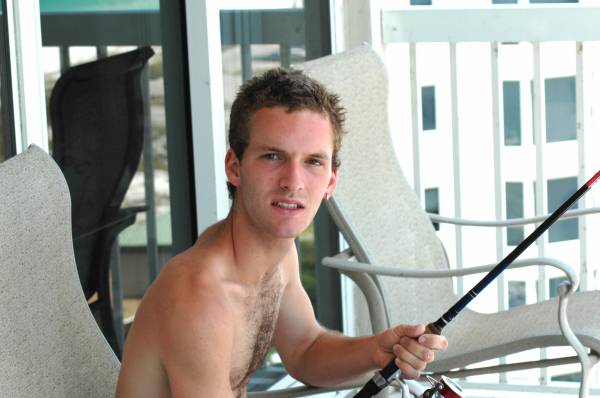Me: Hi, Jamie.
Jamie: Hi, Elisa.
She laughs.
Me: What?
Jamie: We do this on Facetime, and it comes on with a little bit of a jingle, and Erik was mimicking it to a t. And he was doing that goofy swinging of his arms. It was funny.
Me: Ah, man, I wish I could see that! Hi, Erik.
Erik: Hi, Mom. Hi, everybody. Hi, Channeling Erik family.
He waves.
Me: Okay, we’re going to talk about how to communicate with loved ones. I don’t know of anybody, but I’m sure there are, who hasn’t lost somebody.
I put air quotes around the word, “lost.”
Me: And I put air quotes because I know we don’t lose them, and there’s no reason why you shouldn’t continue to have a relationship with them like I do with you, Erik. So let’s talk about that. What does that look like? How can people continue their relationship with their loved one?
Jamie: I always feel so bad when you ask something so deep, and I giggle and smile. Erik said, “I love my mommy so much.”
Erik: Did you just hear her? When you used the air quotes, that was really funny.
I chuckle.
Erik: I’m so proud of her.
Me: Aw.
Erik: It’s not a loss thing. It’s a transition thing.
Me: They just lose their body.
Erik: I am going to put out there one more time—
Jamie laughs.
Erik: Will somebody please create a better vocabulary for all the new knowledge that we have. We need a word for this, man. When you have a (air quotes) transitioned loved ones—and I think we should include animal companions—
Me: Oh, sure!
Erik: Because we have emotional connections to them.
Me: Of course.
Erik: We can’t just leave it at people because anyone, animal or person, who has crossed over, we have this need to carry on the relationship. I call it structuring a new relationship. How do you touch and communicate how you used to do [before they died]?
Jamie (smiling): He’s talking in circles. We’re going to straighten him out right now.
Me: Okay, good luck! I’ll let you handle that!
Jamie laughs.
Jamie: He’s talking in groups, and I want him to be more linear. I think it’s easier for us to listen to.
Erik: When someone transitions, the first thing is, how are you going to perceive this transition? Is it really going to be a loss to you? If it’s a loss, then the energetic vibration of that emotion “lost” is going to really cut new ways to communicate with your loved one.
Me: Why is that?
Erik: Well, cuz it’s a belief, you know, Mom. If you believe in it, that you really lost this person or “ashes to ashes,” then this is the experience you’re going to create for yourself, and so you’re putting yourself in a box and feeding yourself answers like, “Damn straight, this is all bullshit. This doesn’t work. Never fucking happens to me!” That’s because you don’t believe in it. Why would it be happening to you?
Me: Because thought creates reality.
Erik: Yes. Thoughts create belief systems and belief systems create reality, so you gotta straighten out that shit first.
Jamie giggles.
Jamie: The visuals are really funny. We can skip that because it might set off my gag reflex again like before.
Me: Oh no!
Erik: So, once you have that belief system straightened out and see it as a transition, then you gotta figure out what is the way that you can perceive energy the easiest. Like do you see it better, daydream it better, hear it better, feel it better? To know that answer, you gotta figure out how to learn, in that human life, how you do it easiest. Are you a visual learner, audio learner, kinetic learner? Pick one of those, and then we’ll take that and explore it in learning how to perceive and understand that subtle light energy, which is what your loved one just became. It lost the body—I say it. He, she, animal, lost the body and now has become subtle light energy, which is, hello, what the fuck you are! You’ve got a body encasing it.
Jamie (laughing): He’s so sassy!
Me: That’s true.
Erik: So you’re the same thing.
Jamie: He’s getting up on his soapbox! “C’mon, people! What the hell is going on?”
Me: I’m telling you!
We both laugh.
Me: We tend to be a little dense sometimes. Sorry, it’s a human thing.
Jamie: He gives me a picture in my head of, you know, those medicine things that you fill out that have Rx and this is your prescription.
Me: Oh yeah.
Jamie: And it says, “Being human.”
She mimics a doctor tearing off the prescription and handing it to a patient.
Jamie: “Here you go. Oh yeah, you’re dense headed. It’s because you’re being human.”
Erik: Once you figure that out, and you understand it, let’s say you’re visual. You like to see things, so it’s not really going to come with words or descriptions. It’s just going to be seeing. So you have to figure out how to see subtle light energy. It’s almost like testing our five senses and putting them in strained situations.
(Pause)
Jamie: Yeah, yeah, yeah. I heard Erik talking about this the other day. Well, it was probably a month ago.
Erik: You put yourself in a dark room and leave your eyes open.
Me: Does it have to be pitch black?
Erik: Pitch ass black.
Me: That’s hard.
Erik: Where you do this (waves his hand over his face) and you don’t see it happening, that’s what I want. You’re used to opening up your eyes and seeing depth perception—where you are in a room, a horizon line, all that jazz, so your eyes have the expectation to feed you that information. You’re used to that shit. Now you’re in the dark and you’re opening your eyes and you’re like (gasp.)
Jamie chuckles.
Erik: You can’t see the horizon; you can’t see what’s in around you. So you eyes are going to look harder. They’re going to look in a different way. This is the time that you can use your sense of sight in a different way. So if you keep your eyes open and softly gazing into space—it’s not on something because you can’t see an item, so it’s softly [gazing into] space—you’re start to see subtle light energy in the darkness. Of course some of it looks like squiggly things and cells, but that’s actually very low light shining on the cells [in the back of your eye] and projecting. For some of that shit, if you move your eyes and those squiggly things go with it—
Me: Oh, those are floaters.
Erik: Yeah, that’s not subtle light energy. That’s you seeing the reflection of your cells, flakes and shit like that in the back of your eye.
Me: Okay.
Erik: But if you see blobs of light and you turn away and they stay [in place] and you look back and they’re there, that’s subtle light energy. These kinds of practices can be very valuable. There are other ways to kind of trick your senses like, for audio, listening to static, recording, like on a digital recorder. With touch and sensation, you can get into a flotation tank using water at body temperature. There are so many ways to challenge your senses to work beyond what they’re used to every day.
Me: Well, I remember you told me that listening to binaural beats, which you can download from iTunes, between 14 and 16 Hz with earphones really help. So I tried that, and all of a sudden my mom came in and all sorts of other loved ones. Do you still stand by that?
Erik: Yeah.
Me: Why does that work?
Erik: For lack of time and things like that, it’s giving your brain different vibrational patterning. It’s triggering your brain to listen and behave outside of its usual, “I’m hearing a sound, and it’s this way 15 feet away at this pitch.”
Me: Okay.
Erik: So, it activates different parts of the brain.




